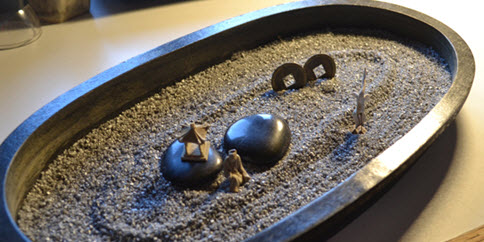By David Square
If you have never experienced the ritual and mystery of a bonseki garden, it is time to create one of your own.
Bonseki is the Japanese art of portraying a landscape on a glossy black-painted tray with white sand and stones. The tray or box becomes a canvas for a myriad of paintings that can be changed with a small rake according to mood or season. Water, waves and waterfalls, mountains, fields and streams are suggested by raking the sand into various scenes. The blackness of the tray is used to symbolize the sea, while stones incorporated into the sand represent mountains or islands.
Bonseki are traditionally made of wood in square, rectangular or oval shapes.
There are no exact dimensions, though generally the trays do not exceed 12-inches by 12-inches by 1 1/2-inches deep, as they are meant to sit on or be recessed into a tabletop.
A square or rectangular bonseki is constructed like a drawer box, the difference being that the bottom of a bonseki sits in a half-groove, so the bottom is flush with the sides of the tray. Also, the corners of a bonseki are usually mitred to give the box a finished look. I find that hidden spline/mitre joints are stronger and easier to glue up than straight mitres.
A simple method to construct an oval bonseki is to draw an oval on the top of a 1½-inch thick piece of wood, and then cut out the oval on a bandsaw; a good jigsaw will do the same job on a softwood like pine, but likely burn a hardwood like maple.
Once the outside of the oval has been cut, draw a smaller oval on the blank, leaving ¼-inch to ½-inch of wood to form the sides or walls of the box. Using a bandsaw, make an entry cut into one end of the oval and follow the interior line until you are left with an oval that looks like a mirror frame. The entry cut is hidden by gluing a sliver of matching wood into the kerf. If you own a bandsaw with a blade welding feature, you can snap the blade, thread it through an appropriate size hole drilled in the middle of the oval blank and reweld the blade before cutting the wood. This technique makes an entry cut unnecessary. For a jigsaw, simply drill an entry hole through the wood and cut out the oval.
A pneumatic cylinder sander fitted with #80-grit paper is useful for smoothing the oval’s inside and outside kerfs. Follow up with #120-grit to remove visible scratches on the wood’s surface.
If the bonseki is to be inset into a hole cut into a table top, add a ¼-inch thick lip to the top edge of the tray to prevent it from sliding through the hole; friction fits are not recommended because a completed bonseki will contain weighty sand and stones.
My wife fills her bonseki gardens with fine white sand gathered from the beaches of Lake Winnipeg; a darker gravel found closer to the water’s edge also creates a lovely landscape for a garden.
Rough, triangular pieces of shale are perfect for portraying rugged mountains; smooth pebbles and rounded river stones are ideal for suggesting islands or fields.
Bonseki owners can spend many delightful hours raking and re-working their gardens, a creative act that composes the mind and awakens the soul through the contemplation of mystery and ritual in beauty.



